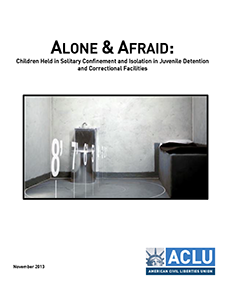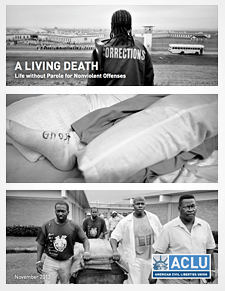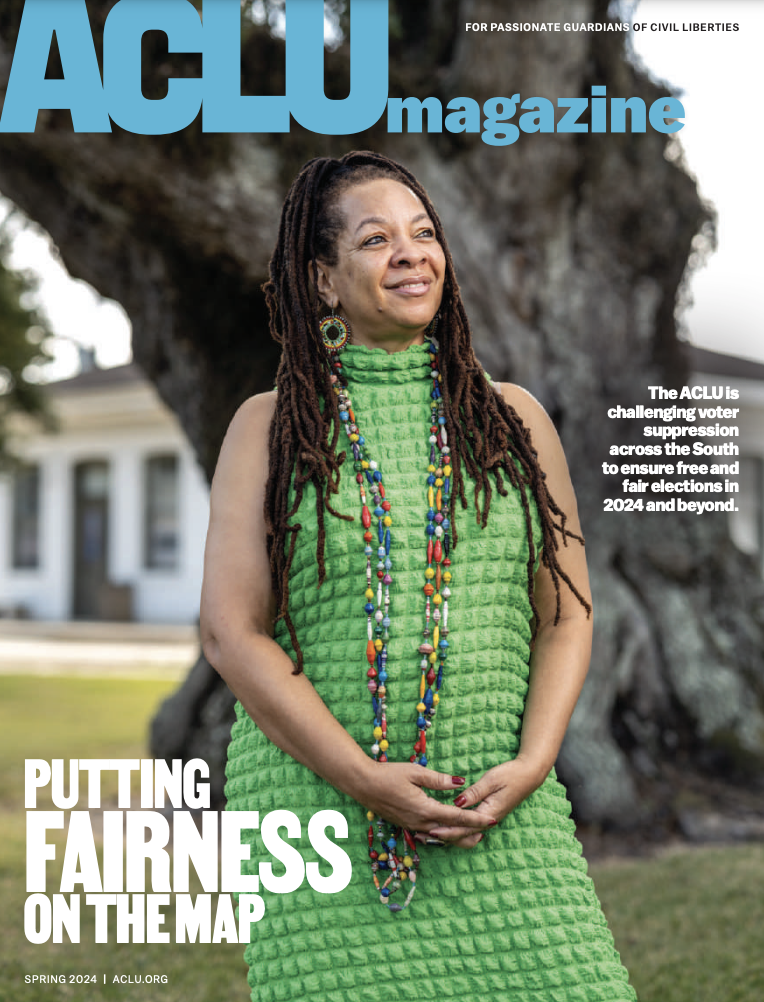Research & Publications
Access in-depth resources and analysis published by the ∫Ï–” ”∆µ regarding our most pressing civil liberties issues.
∫Ï–” ”∆µ 2024 Annual Report
The ∫Ï–” ”∆µ‚Äôs 2024 annual report highlights how the organization worked around the clock this year to safeguard voting rights ahead of the November elections, protect bodily autonomy, defend free speech, and much more. Alongside breakdowns of the ∫Ï–” ”∆µ‚Äôs key wins and efforts throughout 2024, the report tells the stories of ∫Ï–” ”∆µ activists, advocates, and clients who are on the front lines of this fight.
All Publications
Search will open in a new tab using DuckDuckGo
Alone & Afraid
The solitary confinement of children is child abuse, plain and simple. And still, on any given day in this country, juvenile justice facilities routinely subject the 70,000 kids in their care to solitary confinement. Solitary can cause extreme psychological, physical, and developmental harm. For adults, the effects can be persistent mental health problems, or worse, suicide. And for children, who are still developing and more vulnerable to irreparable harm, the risks of solitary are magnified – particularly for kids with disabilities or histories of trauma and abuse.
This toolkit provides advocates with comprehensive resources to end the solitary confinement of kids. Follow the links below to explore the toolkit's resources. For a brief background of the problem of youth solitary in juvenile facilities and solutions to it, read Alone and Afraid: Children Held in Confinement and Isolation in Juvenile Detention and Correctional Facilities.
Start a Campaign: Protecting Children from Isolation
In order to lay the groundwork for an effective Stop Solitary campaign focused on juvenile detention and correctional facilities, it is important to gather as much information as possible regarding the juvenile detention policies and practices in your jurisdiction as possible. A key part of this work must involve elevating the experiences of young people subjected to isolation. These tools include guidance on how to start a campaign, including pointers on how correspond and talk to these young people, how to learn from their stories, and how to remain sensitive to the trauma of solitary confinement.
- Campaign Dos and Don'ts
- Getting Started - Information Needed to Start a Campaign
- Checklist for a Visit to Juvenile Detention or Correctional Facility
- Interview Guide Talking to Youth about Solitary Confinement
- Interview Guide Sample Consent and Release Forms
- Corresponding with Youth about Solitary Confinement
Changing the Law: Advocacy Materials and Model Legislation
Legislation can be a key element to successful reform. The Juvenile Justice Stop Solitary Act is one proposal to limit solitary confinement and other forms of isolation in juvenile detention and correctional facilities. These resources provide more information about the proposed legislation, additional guidance on advocacy, and discussion of the impact of the Prison Rape Elimination Act and international law on the solitary confinement of youth.
- Model Juvenile Justice Stop Solitary Act
- Two-Pager: Solitary Confinement and Isolation in Juvenile Detention and Correctional Facilities
- PREA Two-Pager
- National Standards Restricting the Solitary Confinement of Youth
- International Law and Practice
National Standards and Policy Goals
One of the first questions you may be asked in your campaign is, “what is the alternative?” Fortunately, this question has been thoroughly addressed by a variety of experts. Every set of standards or national best practices for caring for youth in confinement settings strictly regulates isolation. These tools provide guidance on additional strategies to end the use of solitary confinement against children, as well as policy proposals from organizations like the American Academy of Child and Adolescent Psychiatry.
War Comes Home: The Excessive Militarization of American Police
Across the country, heavily armed Special Weapons and Tactics (SWAT) teams are forcing their way into people‚Äôs homes in the middle of the night, often deploying explosive devices such as flashbang grenades to temporarily blind and deafen residents, simply to serve a search warrant on the suspicion that someone may be in possession of a small amount of drugs. Neighborhoods are not war zones, and our police officers should not be treating us like wartime enemies. However, the ∫Ï–” ”∆µ encountered this type of story over and over when studying the militarization of state and local law enforcement agencies.
This investigation gave us data to corroborate a trend we have been noticing nationwide: American policing has become unnecessarily and dangerously militarized, in large part through federal programs that have armed state and local law enforcement agencies with the weapons and tactics of war, with almost no public discussion or oversight. Using these federal funds, state and local law enforcement agencies have amassed military arsenals purportedly to wage the failed War on Drugs, the battlegrounds of which have disproportionately been in communities of color. But these arsenals are by no means free of cost for communities. Instead, the use of hyperaggressive tools and tactics results in tragedy for civilians and police officers, escalates the risk of needless violence, destroys property, and undermines individual liberties.
The Senate Torture Report
The executive summary, findings, and conclusion of the Senate Intelligence Committee’s landmark torture report.
Miscarriage of Medicine
The number of Catholic acute-care hospitals has been increasing rapidly, threatening women's access to reproductive health care, according to a report released by the ∫Ï–” ”∆µ and The MergerWatch Project. The report finds that:
Between 2001 and 2011 the number of Catholic-sponsored or -affiliated hospitals increased by 16 percent, while the overall number of hospitals nationwide declined.
In 2011, one in ten acute-care hospitals were Catholic-sponsored or -affiliated.
That same year, 10 of the 25 largest hospital systems in the country were Catholic-sponsored.
With the rise of Catholic hospitals has come the increasing danger that women's reproductive health care will be compromised by religious restrictions. The Ethical and Religious Directives for Catholic Health Care Services (the Directives), issued by the U.S. Conference of Catholic Bishops (USCCB), govern care at these facilities. The Directives prohibit a range of reproductive health services, including contraception, sterilization, many infertility treatments, and abortion care, even when a woman's health or life is in danger. Moreover, they often restrict even the ability of hospital staff to provide patients with full information and referrals for care that conflict with religious teachings.
The report also shows that Catholic hospitals do not provide more charity care or care to the poor than the average hospital. The report includes recommendations about how to ensure Catholic restrictions do not interfere with patients' rights and to protect access to comprehensive reproductive health care.
A Living Death: Life without Parole for Nonviolent Offenses
For 3,278 people, it was nonviolent offenses like stealing a $159 jacket or serving as a middleman in the sale of $10 of marijuana. An estimated 65% of them are Black. Many of them were struggling with mental illness, drug dependency or financial desperation when they committed their crimes. None of them will ever come home to their parents and children. And taxpayers are spending billions to keep them behind bars.
READ STORIES FROM A LIVING DEATH
Explore the Report:
- Executive Summary
- Recommendations
- Methodology
- Findings: The Use of Life without Parole for Nonviolent Crimes
- How We Got Here: Skyrocketing Extreme Sentences and Mass Incarceration
- Case Studies: 110 Offenders Sentenced to Die in Prison for Nonviolent Crimes
- First-Time Nonviolent Offenders
- Nonviolent Teenage Offenders
- Tying Judges' Hands: Mandatory Life without Parole
- Life without Parole for Nonviolent Offenses under Habitual Offender Laws
- Life without Parole for Marijuana
- Life without Parole Due to Crack/Powder Cocaine Sentencing Disparity
- Aging and Elderly Nonviolent Prisoners
- Terminally Ill Nonviolent Prisoners
- The Reality of Serving Life without Parole
- The Financial Cost of Sentencing Nonviolent Offenders to Life without Parole
- Comparative International Practice and Fundamental Rights to Humane Treatment, Proportionate Sentence, and Rehabilitation
∫Ï–” ”∆µ Magazine
Published twice a year, ∫Ï–” ”∆µ Magazine shares updates on the ∫Ï–” ”∆µ's critical litigation and advocacy work across the country and tells the stories of the activists, attorneys, and clients at the heart of each case and campaign. To receive ∫Ï–” ”∆µ Magazine by mail, become a monthly donor today.











